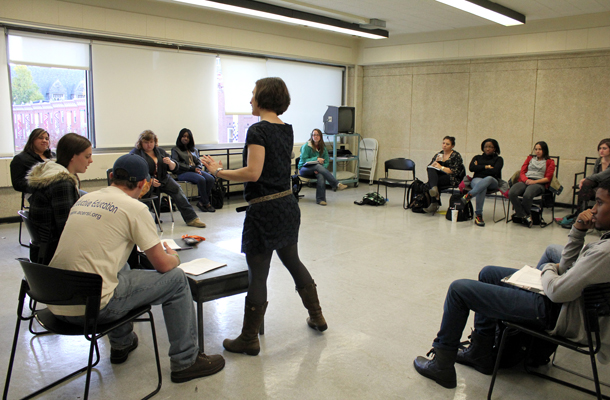
Current 20/20 plans do not include space for theater rehearsal.
In mapping out the projects in the university’s 20/20 plan, many details are not yet finalized, raising questions from both students and faculty–especially among those in the theater department.
According to 20/20 documents, the university calls for a 72 to 110 percent increase in green space, some of which will line the area where Barton Hall currently sits. A part from its use by the College of Science and Technology and the political science department, Barton houses rehearsal studios for those involved in the theater department.
“After checking with the dean’s office I can tell you that no one has received any official notification of any changes in the use of Barton Hall,” interim theater department chair Marie Anne Chiment said in an email.
The department uses rooms on the third and fourth levels of Barton, three of which are specifically designed for theater programs.
Originally designed for dance students from the Boyer School of Music and Dance, the rooms have floor-length mirrors, spring-loaded floors, noise-reducing walls, as well as storage space for props and equipment.
As of yet, the rehearsal spaces in Barton Hall do not have replacement locations, said Margaret Carney, university architect and associate vice president of campus planning and design.
“The 20/20 plan is a framework plan,” Carney said. “The dance studios that are in Barton Hall will be the next step in our process of relocating all of the space out of that building before it’s torn down.”
The green space that is planned to replace Barton Hall will be a “Main Quadrangle,” which “redefines Temple’s identity through significant gathering and play space,” according to 20/20 framework plan documents.
Carney said the proposed Science Education and Research facility, planned to be built at 12th Street and Polett Walk, has a tentative completion date of January 2013. According to Temple’s 20/20 plan website, the project’s $100 million budget is 100 percent funded by “commonwealth capital.”
The creation of a “Tomlinson Head House” for Tomlinson Theater is also suggested in 20/20 plans, to provide interior and exterior gathering spaces and resolve entrance conditions.
Carney said the university will conduct a classroom utilization study with consultants who will help examine how, and for what, all classrooms on Main Campus are used.
Approximately 40 different theater classes, including acting, directing, musical theater, theater literature and theater general education classes use the spaces during this semester, Chiment said.
“The higher up you go [in a theater major,] you can’t avoid being in those rooms,” said senior theater major Sam Han.
Han said she is concerned about the lacking plan for a space to replace those in Barton.
Chauncey Meeks-Owens, a senior theater major, currently takes three acting classes in Barton Hall.
“I’ve had at least one class in that room every semester,” Meeks-Owens said.
“In determining where the dance studios will go, we will certainly be working with dance faculty,” Carney said. “I’m not exactly sure at this point who that person is, but we will certainly be working with the people who oversee those spaces and who are in charge of that department.”
“It’s not just something that’s going to happen suddenly,” she added. “We will be working with them to really understand what the needs are.”
Adjunct theater professor Marla Burkholder said, right now, the rehearsal spaces are “beyond capacity.”
Burkholder said the inadequate amount of rehearsal space was an issue when she was a pursuing her master of fine arts degree in 2003 in the theater department.
“Long term, I think there needs to be a whole study on where theater fits into the college system,” Burholder said, adding that the program has recently boomed.
Last year, the university entertained the idea of merging Boyer and the theater program, to create a college of performing arts. Task force reports recommended against the merger.
“Currently, it feels like theater is tacked onto programs that are less studio-based,” Burkholder said.
Dr. Kimmika Williams-Whitherspoon is an associate professor and the director of undergraduate advising in the theater department.
“We don’t know if we’ll be able to teach the classes,” Williams-Whitherspoon said.
Neither Chiment nor Williams-Witherspoon knew why the spaces were put in Barton Hall to begin with.
“Now that the [Tomlinson] Theater is well known,” Meeks-Owens said, “they need more space.”
Amelia Brust can be reached at amelia.brust@temple.edu.
Angelo Fichera contibuted to this report.



Be the first to comment